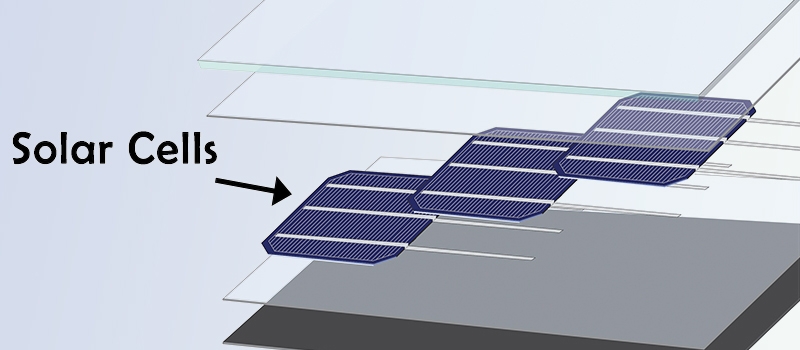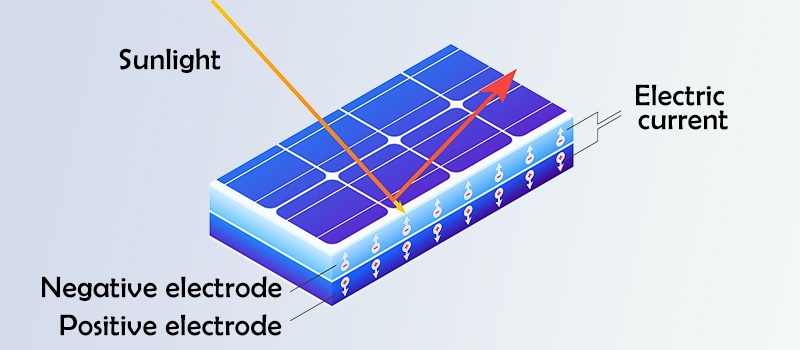Solar energy is an inexhaustible renewable energy source for human beings, and it is also a clean energy source that does not produce any environmental pollution. Among the effective utilization of solar energy, photovoltaic utilization is the fastest growing and most dynamic research field in recent years, and also one of the most popular projects. Are you curious about how solar panels work and how they can power your home? This blog will provide you with a detailed explanation of how solar panels work and solar panel basic knowledges.
Basic Principle of Solar Panels
Solar panels are composed of solar cells, tempered glass, encapsulation materials, functional back sheets, junction boxes, and aluminum frames, of which the solar cells (also known as photovoltaic cells) are the core components and the main body of PV modules, while other components are used to protect and bond the cells.

PV panels generate electricity based on the photovoltaic effect. When light strikes a photovoltaic cell, a portion of the light is absorbed and this absorbed light energy causes electrons to escape, allowing them to flow freely. There are one or more electric fields in the photovoltaic cell that force the electrons absorbed and released by the light to flow in a certain direction. The flow of electrons creates an electric current, which can be drawn out for use by placing metal contacts at the top and bottom of the solar cell. This current, along with the voltage created by the electric field inside the cell, determines the power of the photovoltaic panel.
In the above process, what is used to absorb light energy is the semiconductor material that makes up the photovoltaic cell, for example, silicon is one of the most commonly used semiconductors. Silicon has special chemical properties, especially its crystal structure. The silicon atom contains 14 electrons arranged in three different extra-nuclear electron layers. The first two electron layers closest to the nucleus are completely filled, while the outermost electron layer is half-filled. The silicon atom will always try to fill the outermost electron layer, working to turn the four electrons surrounding itself into eight. To do this, it shares its electrons with the four electrons of neighboring silicon atoms. This crystal structure is important for photovoltaic cells.
Despite having many types, most solar power panels use crystalline silicon. Of these, monocrystalline silicon solar panels are the earliest developed and most widely used type of solar panels, as well as having the highest power generation efficiency. With this basic information about solar panels in mind, the next step will be to analyze how it works in detail, using a monocrystalline silicon solar panel as an example.
Working Process of Solar Panels
The silicon that makes up solar cells is not pure crystalline silicon, but is mixed with impurities. Often, people think that impurities represent something bad, but this is not the case. Without these impurities, the cell will not work. Generally, the impurities that are mixed into crystalline silicon are boron and phosphorus.
First, we know from the above that the silicon atom is surrounded by 4 electrons. After crystallization, it changes to 8, as shown in the figure:
![]()
Boron atoms have only 3 electrons in their outer layers, and when doped into silicon atoms, a hole is created. This hole becomes very unstable because it has no electrons, and is easily neutralized by absorbing electrons, forming a P (positive) type semiconductor:
![]()
The phosphorus atom has 5 electrons in its outer layer, and when it is doped into the silicon atom, one of the extra electrons becomes very active, forming an N (negative) type semiconductor:
![]()
When a P-type semiconductor comes into contact with an N-type semiconductor, what happens is that the extra free electrons rush towards the holes in a frenzy, trying to fill them up. Not only that, but the holes in the P-region spread to the N-region as well. However, not all the free electrons will fill all the holes. At the junction, they mix to form a barrier that makes it harder and harder for the electrons on the N-side to reach the P-side, eventually reaching a state of equilibrium that creates an electric field separating the two sides. This electric field allows the electrons on the P-side to flow to the N-side, but blocks the electrons on the N-side from entering the P-side, creating a potential difference known as a P-N junction.
When light strikes photovoltaic cells in the form of photons, their energy causes electron-hole pairs to be released. Each photon carrying enough energy releases exactly one electron, which creates a free hole. If this happens close enough to the electric field, or if the free electrons and free holes happen to be within its sphere of influence, the electric field will send the electrons to the N-side and the holes to the P-side. This causes the neutrality of the silicon to be destroyed. If we provide an external current pathway (wire), the electrons will flow through that pathway to their original side (P-side), where they merge with the holes sent by the electric field and do work in the flow. The flow of electrons provides the current and the electric field of the cell produces the voltage, and with current and voltage, there is power.

Energy Loss
However, in the process of solar light conversion, there are bound to be energy losses. The main energy losses include:
- Reflection: Due to the smooth surface of crystalline silicon, a portion of the sun's rays are reflected back and cannot be absorbed and utilized.
- Projection: Part of the light passes directly through the solar panel.
- Heat loss: Part of the light energy will be absorbed by the solar panel and converted into heat energy, resulting in energy loss.
In order to minimize energy loss, the following measures are usually taken:
- Reflective layer: A layer of reflective material is applied to the surface of the PV panel, which can redirect the reflected light to the panel surface.
- Anti-reflective film: A protective film with a very low reflection coefficient is applied, which can reduce the reflection loss to 5% or even less and improve the light absorption.
- Multi-layer structure: Solar panels of different materials are stacked on top of each other so that different wavelengths of light are each absorbed and utilized in the most efficient way.
Above is the working principle of solar panels and the solar cells in them. At present, the application of solar power has been from the military field, aerospace field into industry, agriculture, commerce, communications, household appliances and public facilities and other sectors, especially can be decentralized in remote areas, mountains, deserts, islands and rural areas. If you want to put the sun's rays to work as well, you may want to purchase a portable solar panel of your own. Although the current cost of solar panels is high, but in the long run, as countries pay attention to environmental issues and the huge demand for renewable clean energy, solar power still has a bright future.
(1).png)
(1).png)